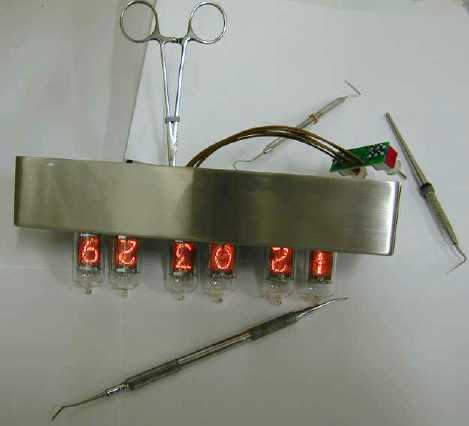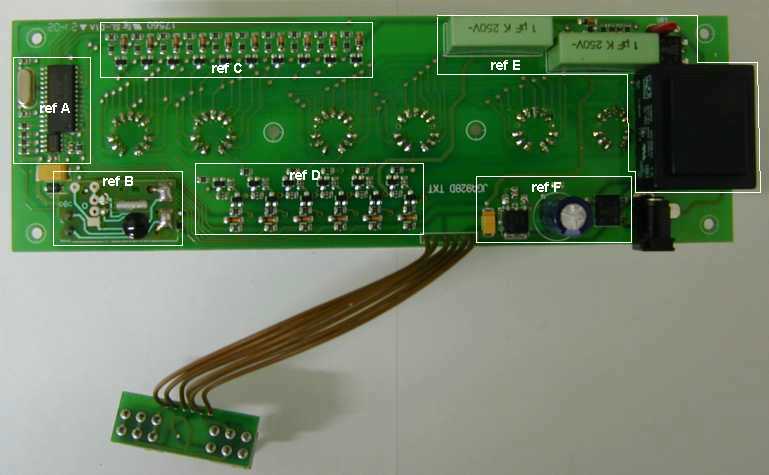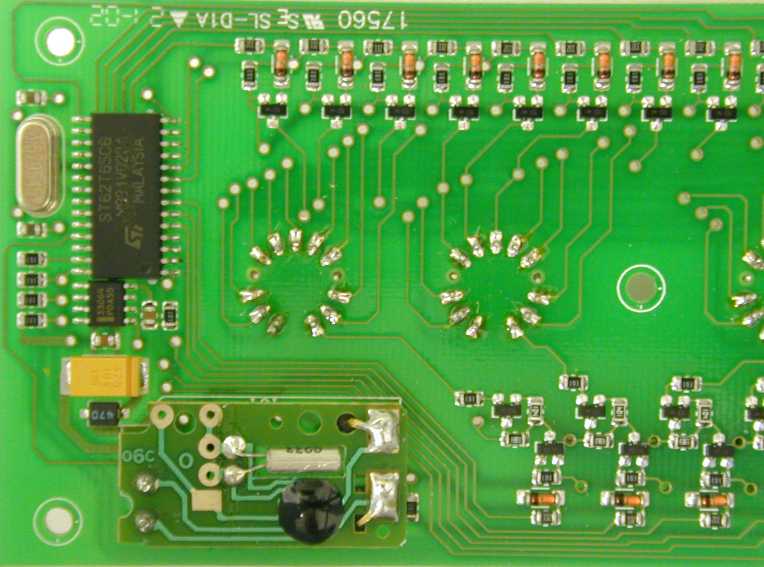 The design is out there...
The design is out there...
- Probing into the Karlsson Nixie Tube Clock -
 The design is out there...
The design is out there...
- Probing into the Karlsson Nixie Tube Clock -
|
It arrived to my office in a plainly wrapped box. The UPS driver had given the beast a reassuring kick from his truck to my doorstep, assuring the fate of this unfortunate being. Our eyes met. We both knew that whatever was concealed inside had surely expired during it's long journey in the brown freight transport. I hesitated, and a shiver raced down my spine as I reached out to pick it up. Then with innards rattling -I carried it into the examination facility. Cautiously, I opened the cube shaped exo-structure to expose the crude chronomatic life-form being suspended inside the generous polystyrene nodules. They clung to me in a strange attraction, with suspicion they were attempting to protect the passenger. I applied 115vac to the beast, and it flashed a reassuring 00:00:00. Though it was alive, all memory of it's past existence had failed. No battery. Darn. It's strange -metallic- appearance had concealed the simple workings inside. It was time to commence the probing... Recently, I acquired a Karlsson nixie tube clock.
Surprisingly small, the base was quite heavy; due in part to the one piece cast, nickel-plated base design. It looked as though it would be right at home in a Pottery Barn or Restoration hardware store, sitting next to a reproduction of a 50's style phone. I fumbled with the two toggle switches at the back. Not intuitive, and neither were marked to indicate their function. Being a normal guy, I refuse to look at the blurblet that accompanied it for directions. Besides, it was only a single paragraph of instructions in English, Spanish, German, and Ebonics. After a bit of fiddling, I was able to set the time. Toggle A moved left sets the hours, toggle A to the right sets the minutes. Toggle B selects either 12 ot 24 hours display mode, with the center position turning the clock off !? Who'd want an on-off switch on their clock? Besides, you have to reset the time whenever you shut it off by accident. |

|
|
|
| The Karlsson clock is a microprocessor driven clock containing six
small side-viewed Nixie tubes. The tubes appear to be ZM1080, or similar
Nixies, and have had their orange filter mask film removed at some time
before the final assembly. Some of the mask film remained on the exhaust
tips of the nixies. The nixie tubes were directly soldered into the main
PCB, and spaced above the PCB using 8mm nylon discs. During clock operation,
digit and anode "ghosting" was obvious on most of the tubes. The ghosting
effect is a result of the high frequency used to switch the nixie anodes,
and the capacitance effects of the cathodes. The ghosting could have been
avoided by careful engineering, or by changing the programmed display timing.
The Karlsson clock is driven in a multiplex scheme, whereas all of the same digit cathodes in the six tubes are paralleled together. Illumination is controlled by switching the +165vdc anode voltage to each tube. Multiplexing makes for a simple clock design that requires few discrete components, and was popular during the days of the nixie tube calculator (late sixties and early seventies). Multiplexing Nixie tube displays do have severe drawbacks though; tube brightness is substantially less than that of a direct drive display, and the excessive current may lead to a reduced tube life. Calculators were designed for intermittent use only, whereas a clock is intended to operate continuously. The Karlsson clock display is very dim, and nearly impossible to read in normal room lighting from a few feet away. I had to disable the camera flash to ensure enough brightness in the first image above. As seen in the image below, extensive use of surface mounted components were used in the clock construction. Now we go into a description of the individual areas outlined below. |

| Reference A outlines the microprocessor. It is an SGS/Thomson
ST62T65C6 8-bit embedded OTP MCU. The program revision: Nixie 1.23 is etched
into the epoxy package. This particular MCU operates from an instruction
set popularized by another major manufacturer's family of microcontrollers,
and may be it's only redeeming value.
Along with the MCU, an 8 pin SOIC reset controller chip: Motorola MC34064 is visible below it. The main oscillator crystal is located to the left. It is 3.58mhz. Reference B outlines a 1pps (pulse-per-second) oscillator assembly
in a separate daughterboard, standing off of the main board. The 1pps signal
is generated using a 32Khz crystal, and divided down to achieve the desired
1pps output. What the heck were they thinking? This has to be the "Rube
Goldberg" winner of the nixie clock design contest!
Reference C outlines the cathode driver section. Ten HV NPN transistors are used to switch the paired cathodes to ground from ten individual MCU output pins. Reference D outlines the Anode driver section. Six intermediate voltage transistors are used to switch another six HV PNP transistors to apply +165vdc at the anode of each nixie tube. Reference E outlines a HV power supply to generate +165vdc for the anode drivers. A transformer, bridge rectifier, and two filter capacitors are visible in the image. The Karlsson clock uses an isolated HV supply based on the "back-to-back" transformer approach. Simply described; the line voltage is reduced to 9vac using a standard "wall wart" adapter, the 9vac is fed into another step down transformer wired in reverse to achieve an isolated 120vac output. The 120vac is full wave rectified and filtered, and provides a DC output voltage of +165v. This HV supply approach is robust and reliable, but requires transient suppression to avoid glitches due to surge and noise. A single MOV or primary side damping condenser would have been sufficient. For that reason, the Karlsson clock is very susceptible to glitches and lockup caused by transients from magnetic ballasts used in fluorescent lamps. Reference F outlines the 5 volt power supply section. An input filter capacitor, three terminal voltage regulator, and output decoupling capacitor comprise the entire circuit. |

A close up showing the 1pps generator mounted on a daughterboard.
Conclusion:
The Karlsson clock is a product built from low cost components, and
required a bit more engineering before it was released to the unsuspecting
consumer.
The shiny metal enclosure is simple and clean, and will always offer
adorning beauty atop the discerning audiophool's shrine to thermionic emission.
;).
|
|
This satire was last
updated 11/27/02